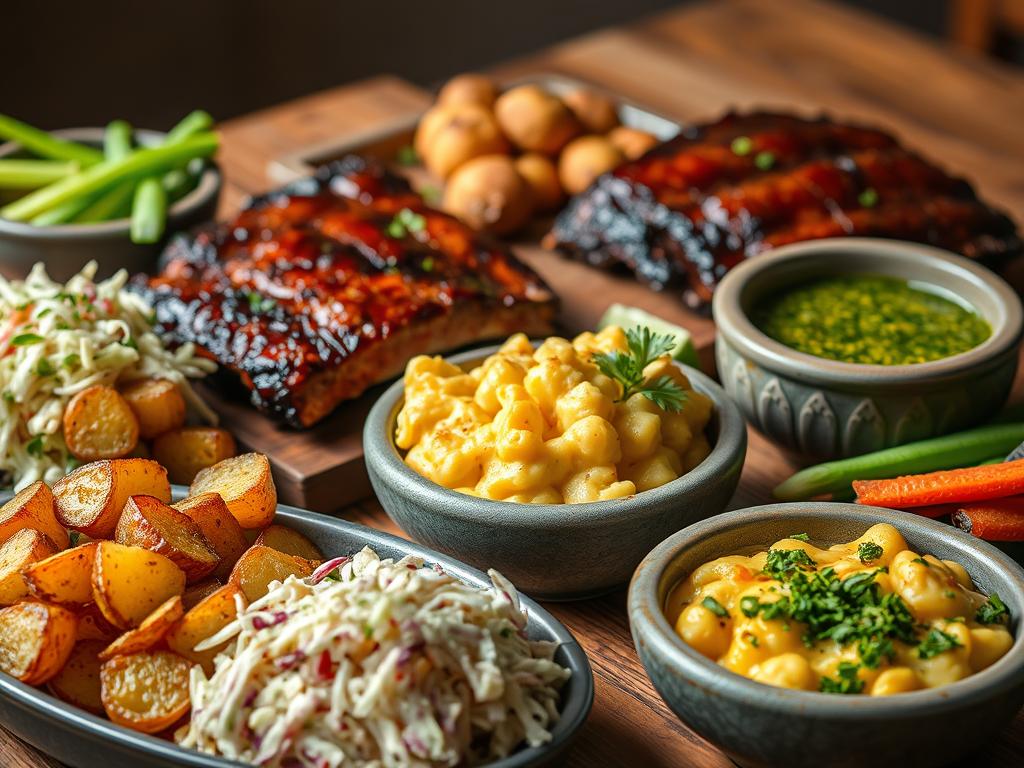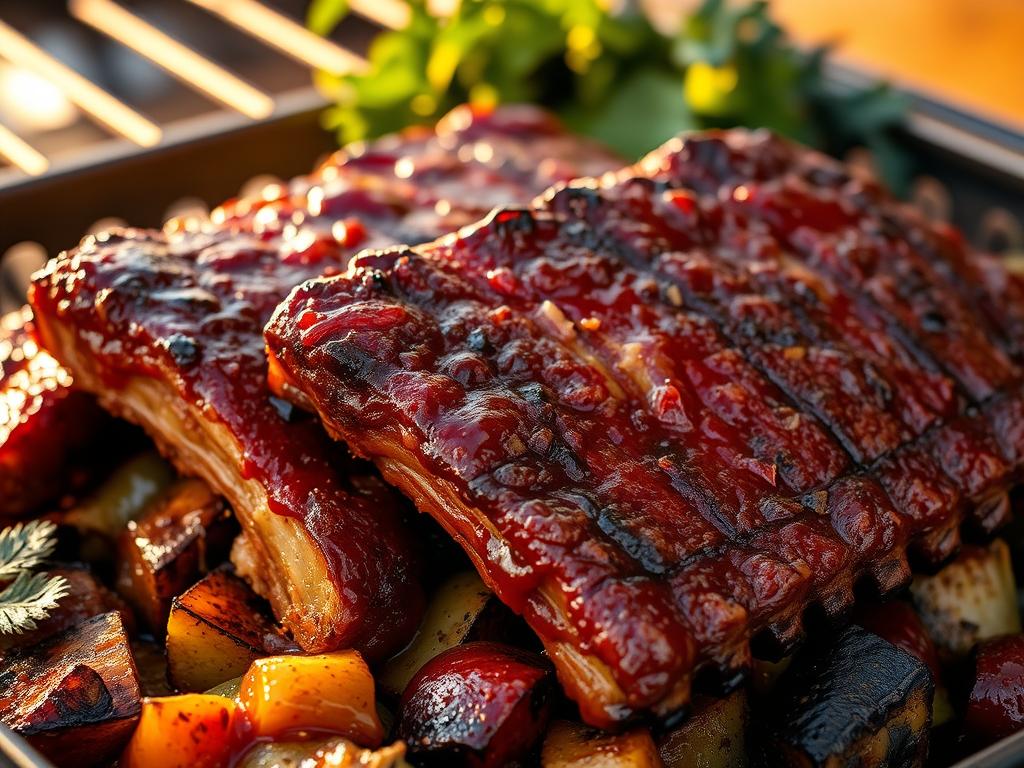The summer sun was blazing, and everyone was excited for a perfect barbecue. I remember the first time I mastered grilled beef ribs. It was a moment that changed me from a backyard amateur to a neighborhood grill legend.
Table of Contents
Grilled beef ribs are more than just a meal. They’re an art form that shows off your barbecue skills. Whether it’s a family gathering or a weekend cookout, these ribs will be the talk of the town. You’ll learn how to pick the right cut and master the grilling technique.
Cooking great beef ribs is about passion, technique, and a bit of magic. You’re about to start a culinary journey that will make your outdoor cooking better. Get ready to make grilled beef ribs that will make your next gathering unforgettable.
Key Takeaways
- Master the art of selecting the perfect beef rib cuts
- Learn professional grilling techniques that guarantee flavor
- Understand the science behind perfect rib preparation
- Discover how to impress guests with restaurant-quality ribs
- Transform your backyard barbecue into a culinary experience
Understanding Grilled Beef Ribs: Cuts and Types
Mastering beef rib cuts is key to great barbecue skills. Not all beef ribs are the same. Knowing their differences can make your grilling better.
Starting your beef rib journey means learning about the main cuts. Here are the most popular ones:
- Back Ribs: From the upper part of the cow’s rib cage
- Short Ribs: Meaty cuts from the lower chest area
- Plate Ribs: Best for Texas-style barbecue
Selecting Premium Beef Rib Cuts
Choosing the right beef ribs is important. Pitmasters say high marbling makes them tender and flavorful. Here are the top beef grades for grilling:
| Beef Grade | Marbling Quality | Recommended Use |
|---|---|---|
| USDA Prime | Exceptional | Exceptional grilling |
| Certified Angus Beef | High | Consistent quality |
| Wagyu | Extreme | Luxury barbecue experience |
“The secret to great ribs is understanding the cut before it hits the grill.” – BBQ Pitmaster
Knowing about beef rib cuts helps you impress your guests. Each cut affects cooking time, flavor, and how they taste.
Preparing Your Beef Ribs for Grilling
Beef rib preparation is an art that turns simple meat into a delicious masterpiece. Before grilling, knowing the key steps to prepare your ribs is crucial. It makes a big difference in your dish’s taste and texture.
Preparing your beef ribs for grilling requires several important techniques. These steps will boost your barbecue skills. The right preparation ensures your ribs are both flavorful and tender.
Essential Marinades for Flavorful Ribs
Marinades for ribs are a secret tool for grill masters. They add deep, complex flavors to your meat. Here are some top marinade tips:
- Acidic marinades with vinegar or citrus juice
- Herb-based marinades with fresh rosemary and thyme
- Sweet and spicy combinations using honey and chili
Dry Rub vs. Wet Marinade: Pros and Cons
| Preparation Method | Pros | Cons |
|---|---|---|
| Dry Rub | Creates crispy exterior | Less moisture retention |
| Wet Marinade | Deeper flavor penetration | Can make meat soggy if over-soaked |
Tips for Properly Trimming Ribs
Proper trimming is key for beef rib preparation. Remove excess fat but keep enough for juicy meat. Pro tip: Use a sharp knife and work slowly to keep the meat intact.
- Remove silverskin from top of meat
- Keep membrane on bone side
- Trim uneven edges for consistent cooking
Mastering these preparation techniques will help you create grilled beef ribs that wow barbecue fans.
How to Marinate Beef Ribs for Maximum Flavor
Learning how to marinate beef ribs is key to making delicious grilled ribs. The right marinade can turn simple beef ribs into a feast for the senses. It adds deep, complex flavors that excite your taste buds.
Marinating is more than just soaking meat in liquid. It’s a delicate process that requires understanding the science behind flavor absorption and meat tenderization.
Timing: Perfecting Your Marinating Strategy
The marinating time is crucial for your beef ribs. Here are some expert guidelines for optimal flavor infusion:
- Minimum marinating time: 2-4 hours
- Ideal marinating time: 6-12 hours
- Maximum recommended marinating time: 24 hours
“The key to a perfect beef rib marinade is balance – too short, and flavors won’t penetrate; too long, and the meat can become mushy.”
Essential Marinade Ingredients
Create a knockout beef rib marinade with these core components:
- Acidic base (vinegar, citrus juice)
- Oil for moisture
- Herbs and spices
- Salt for flavor enhancement
Pro tip: Dry brining with salt for up to 24 hours before cooking can significantly enhance the juiciness and flavor of your beef ribs. This technique helps the meat retain moisture while intensifying its natural taste.
Remember, the perfect beef rib marinade is about experimenting and finding the flavor profile that works best for your palate. Don’t be afraid to get creative with your marinating technique!
Choosing the Right Grill Setup for Beef Ribs
Choosing the right grill setup is key for delicious beef ribs. Your choice between charcoal and gas grilling affects the taste and texture of your dish.

When picking a grill setup for beef ribs, consider the pros and cons of each method. Here are the main points:
Charcoal vs Gas Grilling: Pros and Cons
- Charcoal Grilling
- Offers a deeper smoky flavor
- Allows for more heat variation
- Needs more hands-on effort
- Gas Grilling
- Has easier temperature control
- Starts up quicker
- Provides more even heat
Direct vs Indirect Grilling Methods
For beef ribs, indirect grilling is best. This method involves:
- Placing heat sources to the side of the meat
- Keeping a steady low temperature around 225°F (107.2°C)
- Allowing slow, even cooking to tenderize the meat
“The key to perfect beef ribs is patience and precise temperature control.” – BBQ Master Chef
Temperature Control Techniques
Mastering temperature control is crucial. Use a reliable meat thermometer and adjust vents or burners to keep the heat steady. Aim for low and slow cooking to make your beef ribs tender and flavorful.
The Perfect Grilling Technique for Beef Ribs
Mastering beef rib grilling takes patience, skill, and detail. Your journey to delicious grilled beef ribs begins with understanding how to prepare and cook them.
Preheating the Grill: Setting the Stage for Success
Preheating your grill is key for perfect beef ribs. Make sure it hits 225°F (107.2°C). This low and slow method makes the meat tender and adds smoky flavors.
Cooking Times for Different Rib Cuts
Cooking times for beef ribs depend on the cut and thickness. Here’s a quick guide to help you:
- Short Ribs: 4-6 hours at 225°F
- Back Ribs: 5-7 hours at 225°F
- Plate Ribs: 6-8 hours at 225°F
“The secret to great beef ribs is patience and precise temperature control.” – BBQ Pitmaster
Monitoring Doneness: The Key to Perfect Ribs
To check if your beef ribs are done, use a meat thermometer. The ideal temperature is 203°F (95°C). Look for these signs:
- Meat pulls back from the bone
- Surface has a deep mahogany color
- Meat feels tender when probed
Pro tip: Wrap the ribs in butcher paper during cooking. This keeps them moist and adds flavor.
Adding Flavor: Smoke Woods and Seasonings
To make your beef ribs truly stand out, you need to get good at using smoke woods and seasonings. The right mix can turn your grilling into a memorable experience. It will impress anyone who loves barbecue.
Best Types of Wood for Smoking Beef Ribs
Choosing the right smoke woods is key to getting rich, complex flavors. Each wood type adds its own special taste to your meat:
- Oak: The classic choice in Texas barbecue, it gives a strong flavor
- Cherry Wood: Offers a sweet and mild smoke taste
- Hickory: Gives a smoky flavor like bacon, perfect for beef
- Mesquite: Very intense, use it sparingly
Utilizing Aromatics and Spices for Depth
Seasonings are the magic that makes grilled ribs unforgettable. A good spice blend can take your meat from good to amazing.
| Seasoning Component | Flavor Profile |
|---|---|
| Paprika | Mild, sweet warmth |
| Garlic Powder | Savory depth |
| Black Pepper | Sharp, spicy kick |
| Brown Sugar | Caramelized sweetness |
Pro tip: Start with small amounts of smoke woods for beef ribs. Use 2-4 ounces for a tight cooker, or double that for a leaky one. The goal is to add flavor, not to overpower the beef.
Resting and Serving Your Grilled Beef Ribs
The last steps in preparing grilled beef ribs are just as important as cooking them. How you rest and present the ribs can make a big difference. It can turn a good barbecue into a memorable meal.
The Science of Resting Meat
After taking the ribs off the grill, they need time to let juices spread evenly. Resting the ribs helps the meat fibers relax and soak up moisture. This makes each bite tender and juicy.
- Rest ribs for 10-15 minutes after grilling
- Cover loosely with aluminum foil
- Keep in a warm area away from direct heat
Stunning Beef Rib Presentation Techniques
Your beef rib presentation should be as impressive as the taste. Here are some tips to make your plating stand out:
- Use a large wooden cutting board for rustic appeal
- Slice ribs against the grain for visual texture
- Garnish with fresh herbs like rosemary or parsley
- Drizzle with a complementary sauce
Pro tip: Let your guests see the beautiful caramelized exterior and juicy interior when serving your masterpiece.
Sides and Sauces That Compliment Grilled Beef Ribs
To make your grilled beef ribs unforgettable, pair them with the right sides and sauces. The perfect side dishes can turn your meal into a memorable experience. Your guests will surely ask for more.

Classic Side Dishes to Pair with Beef Ribs
Choosing the right sides is crucial for a great barbecue. Here are some delicious options:
- Creamy Coleslaw – A tangy contrast to the rich beef ribs
- Baked Beans with a smoky twist
- Corn on the Cob with herb butter
- Crispy Potato Salad
- Grilled Vegetable Medley
Crafting the Perfect Homemade BBQ Sauce
A homemade BBQ sauce can take your beef ribs to the next level. Here’s a simple recipe for a sauce that complements your grilled masterpiece:
- 1/2 cup ketchup
- 1/4 cup brown sugar
- 2 tablespoons apple cider vinegar
- 1 tablespoon Worcestershire sauce
- 1 teaspoon smoked paprika
For a Texas-style sauce, use thin beef stock or minimal seasoning. This lets the meat’s natural flavors shine. The goal is to balance flavors that enhance without overpowering your ribs.
Pro Tip: Always taste and adjust your homemade BBQ sauce before serving to ensure the perfect flavor profile.
Troubleshooting Common Grilling Issues
Grilling beef ribs can be tough, even for experts. Learning how to fix common problems can save your meal. Knowing how to tackle issues keeps your ribs tender and tasty every time.
Moisture is key when ribs get dry or chewy. Wrap them in foil with beef broth or apple juice. This method adds moisture and softens the meat, a trick used by pros.
Keeping ribs from getting overcooked is all about temperature. Use a meat thermometer to check the ribs’ internal temperature. Aim for 203°F (95°C) for the best tenderness. If they’re cooking too fast, lower the grill heat or move them to indirect heat.
Seasoning issues can be fixed by adding a dry rub or basting sauce mid-grill. If ribs lack flavor, brush on barbecue sauce or sprinkle more spices in the last 15-20 minutes. This boosts the taste and saves a bland meal.
FAQ
What are the best cuts of beef ribs for grilling?
How long should I marinate beef ribs?
Charcoal or gas grill – which is better for beef ribs?
What internal temperature indicates perfectly cooked beef ribs?
How can I prevent my beef ribs from becoming tough?
What are the best wood chips for smoking beef ribs?
How long should I let my grilled beef ribs rest?
Can I prepare beef ribs in advance?
Explore More:
How to Make the Best Instant Pot Ground Beef Stroganoff
Beef and Rice Noodles: Easy-to-Make Meal-2025
The Best Recipe For Tex-Mex Enchiladas 2025
Delicious Small Batch Pancakes for Any Occasion
Can You Use Pancake Mix for Waffles?

